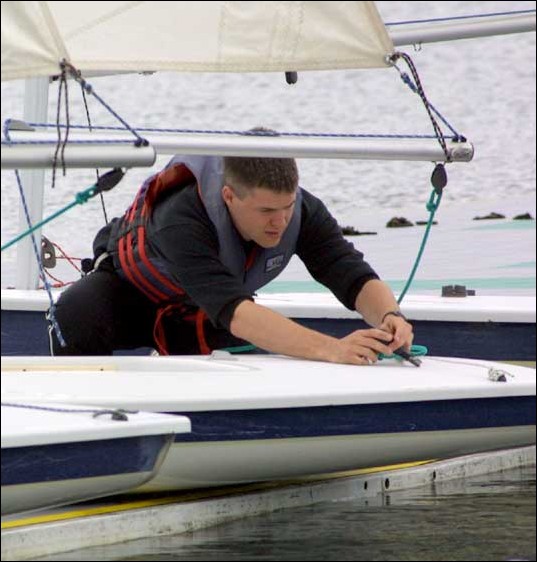Why to take Sailing at Sac State

Image: Why to take Sailing at Sac State:Photo by Katie Johnson/State Hornet:
May 7, 2003
The power of a sailboat has always seemed similar to the workings of a parachute. The sail simply filled with wind and pulled the boat.
Having an engineering student like Chris Ladeas teaching me the ropes, literally, helped me to understand the reality. The contrasting forces of water against keel and wind against sail make the boat slice through the water like a watermelon seed squeezed between your fingers. The speed, conjured from thin air, is exhilarating.
When signing up for a beginners sailing class at the CSUS Aquatic Center, who would expect to really learn enough to take the helm of a boat? Not me. Rigging seemed too complex. Sailing upwind was an impossibility. I even misunderstood this basic lesson about the source of a boat’s power.
I have learned to sail, though. Eight months ago I had never even been on a sailboat. Never having been a boy scout, knots too were a mystery. Today, feeling the pull of the wind through the mainsheet and the tiller of a small boat is thrilling and the thought of being on the water gives the system a little kick of adrenaline.
Beginners’ sailing will clear up all of your questions and give you an exciting new leisure time activity. Chris, one of several part-time instructors at the Aquatic Center, will impress on you some valuable skills. Boating safety and the physics of wind power are taught, in addition to the intuitive function of piloting a sailboat.
Fall semester is a good choice for scheduling. All classes start with a swim test in Lake Natomas. The 80- and 90-degree temperatures of early September provide a more soothing baptism into the world of sailing than the frostbite more commonly associated with late January.
The first instruction in rigging a boat and learning the requisite knots was a little esoteric. Everyone in the 12-person class learned several valuable lessons that windy day at the lake. Because we were rigging our own boats for the first time, it took us all a while to get off the dock.
We were delayed, for the most part, because attempting to untie an incorrectly knotted bowline pulled tighter than Allen Iverson’s cornrows can be a challenge. Lesson one: Even a boat rigged correctly and ready to sail is not much fun while still tethered to the dock. A few experiences like this will force you to learn the correct knot darn quick.
Sailing crisscrossed patterns over the surface of the water, the students were like grade school kids just running and screaming on the playground for no good reason. Lesson two: Once we were on the water most found the prospect of returning to the shore unthinkable. Sailing will make you feel like a kid. It will make you feel alive. Chris was yelling, waving his arms and literally jumping around on the dock in his efforts to get his students in and get himself to an engineering class.
Thousands of years of sailing and the lessons learned over those years by sailors around the world are passed on in this class. Knots have been designed over centuries to meet the specific needs of sailing craft. The knots you will learn about — bowline, figure eight and the cleat hitch — make your work on a sailboat more effortless. Learning the wind dial and how to use its angles and the wind to maintain speed and actually sail toward the wind source is an exciting discovery for beginners. Using the opposing forces of wind and water to make a boat slice through the water, though it is part of the experience of generations of sailors, is a sensation that is difficult to describe.
When your sail is close-hauled and the wind is almost directly in your face, the speed that can be generated is surprising. In the beam reach, while cutting perpendicular to the wind and hiking out of the cockpit because of the heel of the boat, you will find a place where you feel as one with that little Laser. Minute adjustments of the mainsail and rudder can either cut or increase your speed dramatically. Getting the feel of controlling that mainsheet could be compared to learning to carve a turn on downhill skis.
I have been a swimmer almost all of my life. In the past, I treated water safety warnings with a calculated amount of disdain. Sure, I knew that life vests were the law, but I saw the warnings as being for other people. I can swim. I learned the hard way that the warnings of the Department of Boating Safety and Waterways are not idle threats.
You never know what might happen on the water.
No, I was not ticketed for ignoring the life vest law. I was nearly knocked cold by the boom — an apt name — while coming about. At this point it becomes clear that however unconscious you might be about your swimming skills, those skills are pretty useless if you are actually unconscious. The added buoyancy of a life jacket will help you appreciate its value while climbing back into a boat after capsizing in chilly fall weather.
Sailing is, without a doubt, foremost among the new skills I learned in the fall semester. Taking time out of a Wednesday to recharge and get some exercise out on the water is a great way to pick up an extra unit. This opportunity to learn a sport and expand horizons will make you smile every time a gust of wind swirls fallen leaves or cools your face. The water will start calling you.























































































































